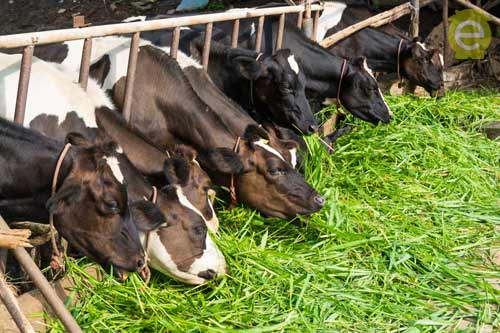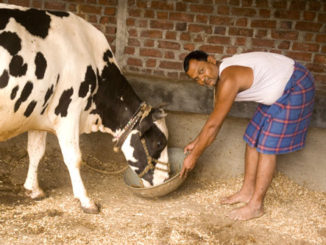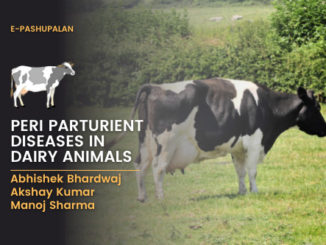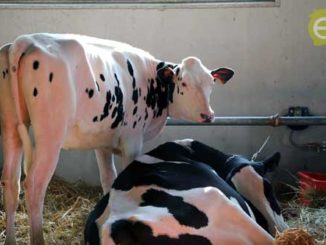Introduction
Effective management of a dairy farm has to focus on individual animal apart from group or herd management since ‘smallest production unit in the dairy is the individual animal’. In this context, precision dairy farming aims to manage the basic production unit in order to exploit its maximal production capacity. Dairy farming is the use of information and technology based farm management system to measure physiological, behavioral and production indicators of individual animals to improve management strategies, profitability and farm performance. Precision dairy farming applications are finding their way on dairy farms, although there seem to be differences in the uptake applications precision dairy farming between dairy systems. The authors have attempted to identify different tools u precision dairy farming utilized across the globe and have highlighted the status of adoption in Indian scenario by highlighting about few farms organizations involved in its utilization and uptake over the years. In this direction, the authors have also focused on several benefits and challenges faced by developing countries including India since the benefits are often not immediately apparent and they require more management expertise along with an investment of time and money to realize. In addition, the adoption rate depends on various factors like farmer education, farm size, perceptions of risk, ownership of a non-farm business etc.

The progressive farmers or the farmers’ groups, with guidance from the public and private sectors, and professional associations, can adopt it on a limited scale as the technology shows potential for raising yields and economic returns on fields with significant variability, and for minimizing environmental degradation. Additional research needs to be undertaken to examine the adoption process for not only successful adoption of technology, but also to solve the issues associated with the technology adoption. Further, right extension approaches and advisory services for the farmers interested in needs Precision dairy farming to be undertaken for its effective application under different socio-economic and ecological conditions.
Dairy production is an important component of livestock farming in India. It is important source of subsidiary income to small/marginal farmers and agricultural labourers. The small/marginal farmers and land less agricultural labourers play a very important role in milk production of the country. Dairy farming is now taken up as a main occupation around big urban centres where the demand for milk is high.
Importance of dairy farming
Dairying provides a source of daily income with a relatively low level of risk. Most of the dairy farmers in India raise animals at a small scale in traditional ways. The productivity of these farmers can be enhanced if they run their business in a scientific manner. Most of such farmers are not aware of the modern methods of dairy farming. As a result, some farmers lose their investment instead of making profit. Milk is a wholesome food among all the animal products. It contains in proper proportions the various essential food ingredients required by human body in an easily digestible form. Inclusion of milk in the human diet increases the digestibility of other types of food as well. The productivity of milk varies in different countries, as some countries are surplus in production, some are deficit in production and in some of the countries, and availability matches their requirement.
The annual milk production in India in 2015–16 was 155.5 million tonnes and the per capita availability of milk was 337 grams per day. In India, milk is produced by a vast number of small, medium and large-sized farms. There is exponential growth in the number of the commercial dairy farms in the urban and semi-urban areas of the metros and big cities. That 49 per cent of milk production comes from buffaloes, followed by 27 per cent, 21 per cent and 3 per cent from crossbred and exotic cows, indigenous cows and goats, respectively. Small quantity of milk is also procured from camel, sheep and yak. Uttar Pradesh is the largest milk producer in India, followed by Rajasthan. The per capita availability of milk is highest in Punjab.
It is interesting to note that in 2016–17, the per Crossbred and exotic cow milk 27% Indigenous cow milk 21% Buffalo milk 49% Goat milk 3% Milk production from dairy animals in India. The demand for milk is constantly increasing in cities as well as small towns and rural areas. The factors influencing this increased demand are rapid increase in population, spread of education, growing nutritional awareness and improved purchasing power of consumers. Dairy farming in India has evolved from just an agrarian way of life to a professionally managed industry. A large number of rural families in India are engaged in dairy production, for which this is an important source of secondary income. In India, raw milk is perceived to be fresh by most consumers and has a large market. Conventional dietary habits in India account for about 60 per cent of milk consumption in liquid form, and the remaining in the form of ghee, cheese, curd, paneer, ice cream, dairy whiteners and traditional sweets.
To ensure maximum production and profits from dairy farming, it is essential that these farmers adopt proper business plans and good dairy management practices. Nearly 43 per cent of Indian farmers are small cultivators, and about 26 per cent are agricultural labourers who have one or two milch animals (Planning Commission, GOI, 2009). This indicates that dairy sector provides basic sustenance for small farmers, landless people and agricultural labourers, especially for people in draught affected areas in Rajasthan and Gujarat.
Pre-Requisites for Dairy Farming
Like any other farming, dairy farming also has a list of pre-requisites. Some of these are as below:
- Affection towards cows and buffaloes
- Basic cleanliness practices
- Knowledge about managing dairy farm scientifically
- Business tactics
- Ready to work hard day and night without a holiday
House Construction in Dairy Farm
The cattle shed must have a floor space of 10 feet by 5.5 feet per animal with a 1.5% slope towards the drain. The floor must be made of rough concrete material. The sheds must be at least 10 feet high. They may be constructed using bricks, RCC or can be thatched. Only the western side of the shed must be walled while the other three sides must be left open. However, the open sides must be covered with gunny cloth during winter to protect the animals from cold. There should also be a provision for sprinkling water on the animals every half hour during summer. This reduces heat stress to a great extent. The eastern side of the shed is open outdoors for free roaming space. The roaming area is covered with trees providing shade. Neem and mango trees are the most preferred trees for shade in the roaming area.
Heat Stress Management in Dairy Farm
Animals are extremely sensitive to heat and heat stress affects their milk production to a great extent. Following are the noticeable symptoms of heat stress:
- Panting fast
- Presence of foam or drool around the mouth
- Visible chest movement
- Excessive drooling with open mouth
- Extended neck
Several of the above symptoms occurring together are signs of heat stress. As said before the sheds must have adequate air circulation and sprinklers to spray water. Water evaporation from the body leads to cooling of the body. Thus the body temperature decreases and the animals are comfortable. Therefore, food energy is utilized for milk production and not in other bodily functions like blood pumping, breathing, panting, etc.
Feeding of Dairy Animals
Food is one of the most basic aspects of living beings for they perish owing to lack of food. Cattle feeding cost a total of 70% of the milk production. Cattle are fed with fodder, grains, brans, green fodder, straw, oil cakes and other such cattle feed.
Fodder Provision
Feed for a normal adult animal is 15-20 Kg of green fodder and 6 Kg of dry fodder per day. The green fodder is harvested during the flowering stage and the surplus fodder is preserved for hay. Preserved fodder is used during summers when fresh green fodder is unavailable. It is necessary to strike a balance between the various nutrient requirements for optimal milk production. If the animals are given an exclusive dry fodder diet, then they must be given Urea Molasses Mineral Block as the supplement. They are also fed with bypass protein feed or compound cattle feed for an efficient production of milk and better body maintenance. In case the feed needs changing, the change must take place gradually. To increase digestibility and reduce wastage, fodder is chaffed and they are fed 3-4 times a day in equal intervals. This rationing is an attempt at reducing wastage and increasing digestibility.
Water Provision
Water is needed for digestion, nutrient distribution, excretion, maintenance of body temperature and of course, milk production. Every litter of milk produced needs an additional 2.5 liters of water since milk contains 85% of water. Hence, a normal healthy adult animal requires 75 to 80 liters of water per day usually. This can increase to 100 lifters during summers. They must have regular access to clean drinking water. Crossbred buffaloes and cows are given a bath twice a day during summer to maintain their body temperature.
Pregnant Animals
Female calves must be given good care and proper nutrition to ensure healthy and rapid growth. Rapid growth helps them attain puberty early. They calve at 2 to 2.5 years of age if given timely insemination. Maximum care must be taken during last three months of pregnancy since the foetus develops rapidly at this time. The daily food requirement of a pregnant animal is as below:
| Food | Weight |
| Green Fodder | 15-20 Kg |
| Dry Fodder | 4-5 Kg |
| Compound Cattle Feed | 3 Kg |
| Oil cake | 1 Kg |
| Mineral Mixture | 50 Gm |
| Salt | 30 Gm |
The following points must be considered with utmost priority while taking care of pregnant animals
- Provide enough space for standing and sitting comfortably.
- They must be given adequate amounts of ration to ensure timely milk production in adequate amounts and also to reduce the possibility of milk fever, ketosis, etc. at the time of calving.
- During pregnancy, special attention must be paid to water requirements; there should be round the clock supply of clean, drinking water.
- During the last trimester of pregnancy, the animals must not be taken far away for grazing and uneven paths for grazing must be avoided.
- Lactating animals must be dried within 15 days after the 7th gestation month.
- From the 6th or 7th month of pregnancy, the cow’s body, back and udders must be massaged- this is especially in case of first or second pregnancy (heifer cows).
- Heifer cows are tied along with the milking animals from the 6th or 7th month of pregnancy.
- The pregnant animals are tied separately in a clean and dry area with ample sunlight about 4-5 days before calving.
- Paddy straw is the bedding material for animals and they are spread on the ground.
- During the last 2 days before calving the animals are kept under observation.
Post Calving Care and Nutrition
During calving, animals undergo a lot of stress. Hence they would have a low appetite and tend to eat far lesser than what their body needs. Since the appetite is low the cows and buffaloes are given boiled rice, wheat bran, wheat mixed with edible oil, jaggery, boiled millet, rice gruel, ginger, black cumin, etc. The food must be light, warm, palpable and mildly laxative. This type of diet must be given for 2-3 days after calving and it helps in early expulsion of placenta. It is advisable to give the animal’s fresh green fodder and water. While the ration food must be warm, the water must not be boiled or hot. It should be fresh water. Clean drinking water is very necessary for milking cows else they are likely to develop diseases.
Taking Care of the Newborn
The first 24 hours has a deep connection with its life later. If not given proper care, the calf may develop diseases, perish or be an underperformer. The first hour after birth is called as the ‘golden hour’ since this is a critical period. The following points must be taken care of during that period:
- Clean the mouth and nostrils to help it breathe
- Allow the mother to lick the calf clean as it stimulates circulation and helps the calf stand up and walk.
- Give the calf 2 litres of colostrum (first milk produced) within the first 2 hours of birth and then again 1-2 liters depending on weight of the calf within the next 10 hours.
- The calves must be de-wormed every month upto 6 months of age once the calf is about 2 weeks old.
- Vaccination must be done at the age of 3 months.
- Calves must be provided with starters for good growth and early maturity from the 2nd week of birth.
Importance of Colostrum
Colostrum is an important feed for newborn milk especially is contains high amounts of proteins and antibodies which help build immunity. It helps the calf ward off infections. Most calves do not nurse adequate amount of colostrum from their mothers therefore hand feeding is necessary. This ensures that the calf has the required amount of colostrum. However, feeding colostrum after the first 24 hours has passed would not help in warding off infections or building immunity.
Vaccination of dairy animals
| Name of Disease | First Dose | Booster Dose | Subsequent Doses |
| Foot and Mouth Disease | 4 months and above | One month after first dose | Every six months |
| Black quarter | 6 months and above | Once every year in case of endemic occurrence | |
| Hemorrhagic Septicemia | 6 months and above | Once every year in case of endemic occurrence | |
| Infectious Bovine Rhinotracheitis | 3 months and above | One month after first dose | Every six months |
| Theileriosis | 3 months and above | Once a lifetime dose needed only for exotic and crossbreeds. | |
| Anthrax | 4 months and above | Annually in case of endemic areas. | |
| Brucellosis | 4-8 months of age in female calves | Once a lifetime |
Conclusion
Looking after and maintaining good animal health is the gateway to successful dairy farming in India. Maintenance of animal health, looking after its breeding and nutrition supplemented with proper information system is beneficial. Besides the raw milk there is a huge market of milk products like powdered milk, ghee, cheese etc. Even the waste in dairy farming is valuable and has good market demand. The ‘gobar’ or cow dung is the raw meterial of organic compost or vermincompost. If you’re using ‘desi cow’ or Indian cow breed in your cow farm then the cow urine is a valuable resource to make ‘panchagavya’ or natural insecticide in organic farming.






Be the first to comment